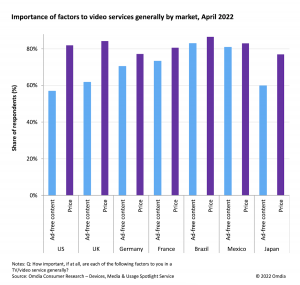
After more than 35 years of operation, TBI is closing its doors and our website will no longer be updated daily. Thank you for all of your support.
TBI Tech & Analysis: Why streaming’s future lies in a hybrid model
Omdia analyst Max Signorelli explores how consumer demand is impacting advertising opportunities for streamers and how service providers can stay ahead of the game.
In the US, hybrid video propositions are nothing new and have secured their position as a core market offering through the likes of Hulu and, more recently, House Of The Dragon streamer HBO Max. Outside the US, however, the business model will feel relatively new with few parallels in the OTT space.
According to Omdia’s consumer research, these customers are also more likely to cite “advertisement-free content” as being important to their video services, making the latest push by Netflix and Disney+ sound like a hard sale.
A key factor here is the differential between the importance of “advertisement-free content” and that of “price” (i.e., value-for-money). Given these factors rank the highest, advertising clearly has a place among consumers’ paid portfolio if it clearly offers accompanying benefits to the value perspective.
As OTT looks increasingly like traditional TV, the lessons from cord-cutting must be heeded. The most important factor for consumers has always been value-for-money, but increasing costs and expensive content need revenue to feed it. Operators should not expect a binary shift in advertising-based consumption patterns in 2023. This is particularly true outside of the US, where free video, particularly from public service broadcasters and other free providers, is so ubiquitous.
Preferred balance
Advertising options offer a newly increased opportunity to engage consumers that may otherwise be put off by additional, or indeed any, monetary services fees. In cases where payment is still taken, however, consumers will continue to expect a pound-for-pound experience.
The preferred balance between advertisement and a monetary fee for consumers is unlikely to be found right away and fixed with time. Service providers should experiment with business models and find what best draws in the target audience at the right time.
As further advertising-funded video options are opened up to consumers, they will expect their platforms to keep up and offer seamless access. Devices will be expected to offer an experience that is not saturated by in- or out-stream advertising.
The future is certainly in hybrid video monetisation and this will change the nature of long established relationships between device platforms and video services. They need to embrace these new operation models early to stay ahead of the consumer.
The excerpt above is from Omdia’s 2023 Trends to Watch: Connected Consumers report, published by Omdia (a part of Informa, like TBI), written by Max Signorelli, principal analyst for media & entertainment, available in full here.




